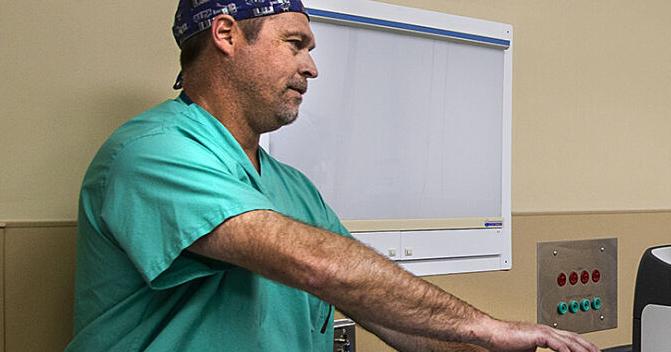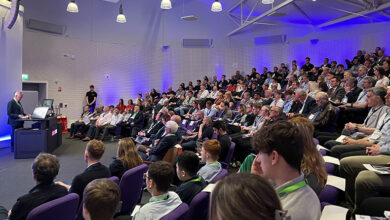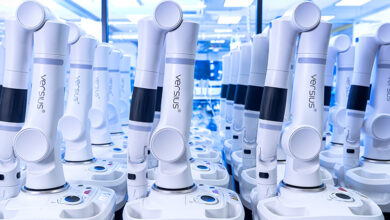Local robotic surgeon hits major milestone of 1,500 cases

When medical dramas picture surgery, there tends to be a lot of blood, guts and gore shown on the TV screen, with several masked providers huddled around an opened body.
It’s a different scene inside the operating room at Spotsylvania Regional Medical Center when Dr. Eric Thomas removes gallbladders or repairs hernias with the daVinci robotic surgical system. Thanks to cameras that have been inserted into the patient through “trocars,” long metal tubes that also hold surgical instruments, viewers can see the insides of a person’s belly on one of three TVs around the room.
There’s no scalpel cutting through flesh, and there’s barely a drop of blood as a tiny tool trims away connective tissue from an inflamed gallbladder and immediately cauterizes the wound to prevent bleeding.
And Thomas isn’t bent over the patient, staring into the abyss. He’s a good 8 feet away, sitting at a console where he looks at the patient’s insides on a high-definition screen and uses his hands to control the robot’s arms and instruments.
People are also reading…
Thomas is a practiced hand at this type of operation with high-dollar and high-tech instruments. In less than 10 years, he’s performed more than 1,500 such surgeries, including almost 200 locally since he and his family moved to the Fredericksburg area from the West Coast in July.
That’s a major milestone in the world of robotics, according to coworkers who recently celebrated his accomplishment.
“I have to believe you are one of the busiest robotic surgeons in the region,” said Ryan DeWeese, CEO of the hospital owned by HCA Healthcare. “Doing 1,500 cases is a big deal and one thing that’s so special about you is how quickly you’ve integrated into this community. I think it’s because of the way you treat people, which is why you’ve been able to get so busy so quickly.”
‘The Robotics Era’
The stars were out during the recent celebration — and that does not necessarily apply to the surgeon, whose coworkers confess looks a little like actor George Clooney.
Meghan and 12-year-old Mikayla, the wife and daughter of Thomas, are big fans of Taylor Swift. Knowing that, Chrissy Hudson, the practice manager at Premier Surgical, and party planner extraordinaire, threw him a soirée suitable for any Swiftie.
A cutout of their idol was front and center, wearing a surgical mask and cap, a stethoscope around her neck. As her songs played on a loop, a poster blasted: “1,500 CASES” with a Swift concert photo and the words: “Dr. Thomas, The Robotics Era.”
His wife gave him a T-shirt that warned the wearer “may spontaneously start talking about robotics” and proved it by saying how many times he needs one in daily life.
“He’ll bake a good brisket and he’ll say, ‘I could cut this up better if I had a robot,’” she said. “Or I’ll say we need to put together the pergola and he’ll say, ‘Well, I could if I had a robot.’”
As she talked, her husband dropped to the floor and struck a pose in front of the cutout as his office staff stood on either side of Swift.
“He has a hard time coming out of his shell,” his wife deadpanned. “He’s extremely reserved.”
‘Phenomenal guy’
Those who work with him in the office, in the Pogonia building on the hospital campus, or in the operating room, sing his praises. At his party, they talked about a patient who called at 4:30 one afternoon, asking if she could get a port installed the next day so she could start chemotherapy treatment. Another procedure had been scheduled but fell through.
Thomas had six cases the next day, but Hudson checked with him and operating room officials to see if they could make it happen. Staff members juggled schedules, working later that night or earlier the next day.
“It’s unheard of, in most places, to be able to get a (non-emergency) patient into the OR within four hours,” said Crystal Jernigan, nurse leader. “He makes his schedule available as much as we can make our schedule available, just to ultimately serve the needs of a patient.”
Jernigan also said she’d never seen a doctor from the other part of the country “get booked up so quickly” as he did within about two months of arrival. Hudson called him the best surgeon she’d ever worked with during 14 years in the field.
“Just his empathy, kindness, (being) patient-forward which is how it should be in health care, but, unfortunately sometimes you don’t always find that,” she said. “And he’s punctual, always on time, his notes are always done and I can read his writing.”
Ed McLaughlin, a surgical assistant, gave Thomas the ultimate compliment.
“I would let him work on my family, work on myself,” he said. “I trust him, he’s a phenomenal guy.”
‘Really cool era’
At 53, Thomas is old enough to have been trained on “open surgery,” when doctors physically cut open a patient to remove the offending organ or repair a problem, to the “revolution” of minimally invasive procedures. First came laparoscopic which is performed by hand with a two-dimensional camera, then robotics which don’t involve R2–D2s, but allow the surgeon to operate instruments from outside the body.
“It was a really cool era,” he said. “I had the old surgeons who taught me and said, ‘Ooh, you had to do it open,’ and I had the young guys who said you had to do it laparoscopic. I got to see both of them and then to pick up robotics, and be able to train some of the younger surgeons, it’s been a pretty cool career.”
Thomas graduated from Eastern Virginia Medical School in Norfolk in 1997 and did internships at Naval Medical Center Portsmouth on a Navy scholarship. He spent 12 years in the Navy, paying the military back for his training before he joined a county hospital in Phoenix.
That’s where he started doing robotics, and training residents. He spent 10 years there until the practice changed and he thought he could make a difference working in rural medicine at a small hospital in eastern Washington state.
“Well, I couldn’t. It’s tough,” he said, about dealing with an extreme lack of resources and treating conditions he hadn’t seen since his days as a resident.
He and his family regularly vacationed with relatives at Smith Mountain Lake, about an hour from Roanoke, and planned to retire in Virginia. They decided to move things up a decade or so, and searched for a position — where he could again do robotic surgery — in the Commonwealth.
He and his wife picked Spotsylvania Regional Medical Center, but hadn’t told Mikayla. She did her own research and came to the same conclusion.
Thomas also is a proctor who can teach robotic surgery to other doctors.
“He’s an amazing guy, he communicates very well and shows other surgeons little tricks of the trade,” said David Garcia, a surgical nurse technician.
Intuitive Surgical, which markets the daVinci products, has certain thresholds surgeons must meet before they can share their skills, DeWeese said. Proctors need to have at least 200 cases under their surgical scrubs.
“You’re over seven times that now,” he told Thomas. “And this is just the beginning.”
Then, the CEO said he couldn’t meet Thomas’ request to have five surgical robots, which cost up to $2 million apiece, and the surgeons to operate them. But DeWeese said he was “willing, hopefully, to commit” to another one.
“You’re not going anywhere for a long time, right?” DeWeese asked.
Cathy Dyson: 540/374-5425
“Doing 1,500 cases is a big deal and one thing that’s so special about you is how quickly you’ve integrated into this community. I think it’s because of the way you treat people …”
-Ryan DeWeese, CEO of Spotsylvania Regional Medical Center owned by HCA Healthcare



